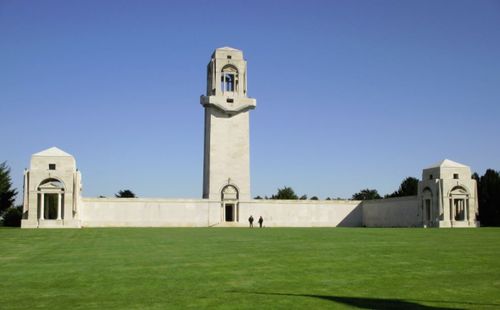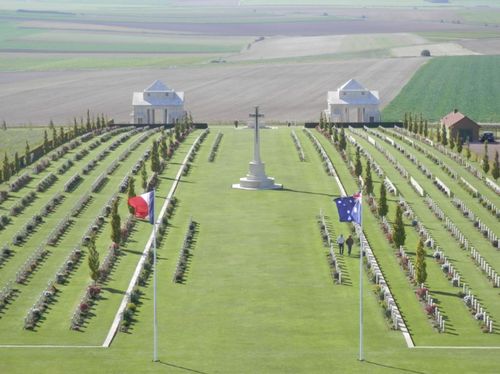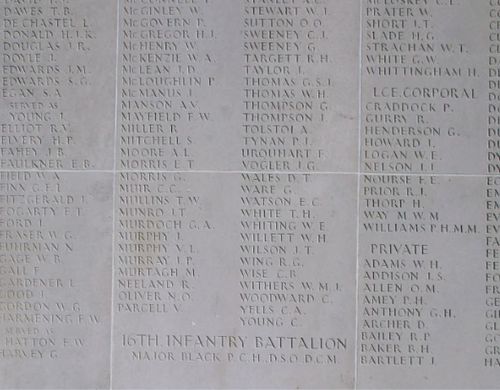Villers-Bretonneux Memorial
From Our Contribution
Contents
History
Following the war, the commander of the Australian Corps, Lieutenant General Sir Talbot Hobbs chose the sites of several Australian memorials in Europe and proposed that a memorial to all of the Australian dead on the Western Front be built in France, in the Villers-Bretonneux area. The proposal was approved by the Australian government – still led by wartime Prime Minister Billy Hughes – in 1923. A competition to design the memorial was held in 1925. It was open only to Australian veterans and their parents; their entries were required to use only stone quarried in Australia. The competition was won by the Melbourne architect William Lucas. In 1929, the French government gave its approval to the project.
The Scullin government suspended the project in 1930, due to the Great Depression and the projected cost, as well as dissatisfaction with aesthetic elements of Lucas's design.[1] Following a 1935 visit to Australia by the head of the Imperial War Graves Commission, Sir Fabian Ware, a cheaper design was sought, using French stone, from Sir Edwin Lutyens.
Construction of the memorial took place in 1936 and 1937. It was unveiled on 22 July 1938 by King George VI, whose words were broadcast directly to Australia. Other dignitaries present included the French President Albert Lebrun, who also gave a speech, and the Australian deputy prime minister Earle Page. Accompanying the King was his wife Queen Elizabeth, whose brother was killed at the Battle of Loos. This memorial was the last of the great memorials to the missing of World War I to be built, and the Second World War broke out just over a year after its unveiling.
Every year on 25 April, an Anzac Day Dawn Service is conducted at the memorial by the Australian Government Department of Veterans’ Affairs. The service commences at 5.30am and is followed by community services in Villers-Bretonneux and Bullecourt.
Setting
The main memorial to Australian military personnel killed on the Western Front during World War I. The memorial lists 10,773 names of soldiers of the Australian Imperial Force with no known grave who were killed between 1916, when Australian forces arrived in France and Belgium, and the end of the war. The location was chosen to commemorate the role played by Australian soldiers in the Second Battle of Villers-Bretonneux (24–27 April 1918).
Designed by Sir Edwin Lutyens, the memorial consists of a tower within the Villers-Bretonneux Military Cemetery, which also includes a Cross of Sacrifice. The tower is surrounded by walls and panels on which the names of the missing dead are listed. The main inscription is in both French and English, on either side of the entrance to the tower. The memorial and cemetery are maintained by the Commonwealth War Graves Commission.
Description
Inscription in English and French on either side of the entrance to the TowerTO THE
GLORY OF GOD
AND
IN MEMORY
OF THE
AUSTRALIAN
IMPERIAL FORCE
IN FRANCE
AND FLANDERS
1916-1918
AND OF
ELEVEN THOUSAND
WHO FELL
IN FRANCE
AND HAVE
NO KNOWN GRAVE
Monument Details
Names are listed by Unit, by rank, alphabetically.
11th Battalion
- LCpl William Moore Crellin
- Pte Thomas Flavin
- LCpl Hector Louis Polain
- Pte Richard John James Bransby
- Pte Francis Dyson
- Pte Frederick James Howard
- Pte George Badham Milton
- Dvr Stephen Henry Robson
12th Battalion
16th Battalion
- L/Sgt Victor Henry Marshall
- Pte Robert Prior Bailey
- Pte Austin Henry (Paddy) Bingham
- Pte Henry Bolton
- Pte Thomas Denteith
- Pte Harold V Marshall
- Pte Ernest Clifford Noyce
- Pte Alfred Arthur (Fred) Rouse
- Pte Herbert Winton Turner
- Pte David Dickson Waddell
28th Battalion
- Sgt Basil Kelley
- Pte David Edward Bromley
- Pte James Willie Bush
- Pte Leonard Butcher
- Pte Reuben Leeuwin Cousens
- Pte Stephen Gittins
- Pte John Richard Lewis
- Pte Harry Pickard
- Pte Charles William Price
- Pte Hubert Harris Thorp
- Pte Albert Edward John Walls
- Pte Claude Algernon Wright
32nd Battalion
- Pte Jim Anderson
44th Battalion
- LCpl Robert Melville Salter
- LCpl Charles Alexander Wann
48th Battalion
- Lcpl Albert Thomas Ticklie MM
- Pte Sydney Fenner Blencowe
- Pte Herbert (Bert) Cumming
- Pte Ernest Rulle Dalziell
- Pte Osborne Fisher
- Pte Walter Stanley Fisher


